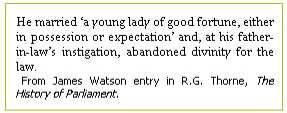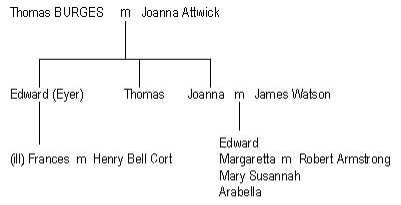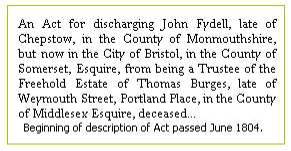 |
 |
Henry Cort Inventor - Creator of puddled iron - Father of iron trade |
 |
 |
| This page is part of a website based on the life and achievements of eighteenth-century inventor Henry Cort. The creator and owner of the site was Eric Alexander who passed away. The site is now hosted by Geneagraphie.com Please contact us with any comments or queries. |
- Homepage
- Life of Henry Cort
- Cort's processes in iron manufacture
- Cort's patents
- Refutation of allegations of conspiracies against Cort
- Adam Jellicoe's death
- Henry Cort's birth
- A navy agent's business
- Early life of John Becher
- Attwick & Burges families
- "Cortship" of second wife
- Thomas Morgan
- Henry Cort's hoops contract
- 1856 Accolade
- Generosity of friends 1789-94
- James Watson
- Illness of Cort's son
- Main sources of information
- Contemporary sources
- Navy sources
- Chancery files
- Publications about Cort
- Assessment of Cort's character
- Images of Henry Cort
Impeach-tranferred to 05
- Parliamentary inquiry 1811-2
- The furore of the 1850s
- Society of Arts
- Cort's first marriage
- Henry Cort's children
- Cort family pensions
- Henry Cort's Hertfordshire property
- 1791 signatories
- Guiana and the Cort-Gladstone connection
- Cort's twilight years
- Memorials to Henry Cort
- Smelting of iron
- Fining before Cort
- Shropshire & Staffordshire ironmasters
- Cumbrians: Wilkinson etc
- Early works at Merthyr Tydfil
- The Crowley business
- London ironmongers
- Scottish iron
- Cort's promotion efforts 1783-6
- Later Merthyr connections
- Puddling after Henry Cort
- Gosport in Cort's day
- Gosport administration
- Gosport worthies
- The Amherst-Porter network
- James Hackman, murderer
- Samuel Marshall
- Samuel Jellicoe's legacy
- Links with Titchfield
- Links with Fareham
- Fact, error and conjecture
- 18th century politics
- Law in the 18th century
- 18th century finance
- Religion and sexual mores
- Calendar change of 1752
- Shelburne, Parry and associates
- John Becher's family
- The Becher-Thackeray lineage
- Thomas Lyttelton: a fantastic narrative
- Eighteenth-century London
- Abolition and the Corts
- The Burges will tangle
- Navy connections
- Navy agent's business
- Cort's clients
- Ships' pursers
- History of Adam Jellicoe
- Dundas & Trotter
- Cort's navy office associates
- Toulmin & other agents
- Sandwich & Middleton
- The Arethusa
- John Becher's war
- Thomas Morgan's war
- The 1782 Jamaica convoy
- Sinking of the Royal George
- Visitors 2006-2009
- Developement of the site 2006-2009
- Daniel Guion and family
- Extremely bad academic work and extremely bad journalism
****************
|
|
THE BURGES WILL TANGLE
This story involves some of Henry Cort's relations and illustrates how complicated questions of inheritance can become.
Source: documents at the National Archives (PRO), including wills of Thomas Burges (married to Elizabeth Cort's aunt Joanna) and his children Edward (Eyer), Thomas (jnr) and Joanna (jnr).
We begin the story in 1770, when Edward joins the East India Company as a writer. The name Burges crops up several times in company records, suggesting that the family has a continuing interest there: another writer starting in 1770 is named David Burges.
 The story continues with Joanna's wedding to James Watson, 14 August 1777 at Titchfield, witnessed by local residents Edward Ives and John Missing.
The story continues with Joanna's wedding to James Watson, 14 August 1777 at Titchfield, witnessed by local residents Edward Ives and John Missing.
Ives is something of a celebrity. On a trip to India (ship's surgeon on the Kent) in 1755 he has kept scurvy out of the ship by feeding the crew with fruit juice, following the recommendations of fellow surgeon James Lind; and has published a book about the trip, which ended travelling overland most of the way home. His son Edward Otto, who has joined the East India Company as a writer in the early 1770s, will play a significant part in this story.
Judging from Ives senior's will, the elder Thomas Burges is in India by March 1780. His wife is probably dead.
Next documentary evidence is the baptism of Edward's illegitimate daughter Frances in Calcutta, 7th January 1785. It's possible that her mother is Indian, which will become significant when she marries Henry Cort's eldest son in 1804.
Edward's father also begets two illegitimate children in India, Elizabeth and George (who appears as a classical scholar in Oxford DNB). Later he takes another wife, Elizabeth Kerr.
Joanna stays in England with husband James Watson. Their first child, Edward, is born in January 1779.
No evidence has yet emerged whether the younger son, Thomas Burges jnr, stays in England during this period. But he is certainly there when he makes his will in September 1789. He leaves a large chunk of his estate in trust for sister Joanna and her children. Trustees are Edward Otto Ives, John Shore, and "John Fydell of Chepstow".
All these three have Indian connections. Indeed, Shore will go on to become Governor General of Bengal. At the time the will is made, he and Ives are both in India.
Fydell has had a spell in India, starting as a writer with the company in 1770, the same year as Thomas's brother Edward.
So how has Thomas come to select these three as trustees? Presumably through his brother's (or possibly his father's) connections in India. We may note that Fydell has returned to England between 1782 and 1785, while Shore has had a spell in England between June 1785 and April 1786.
The will's executors, however, are different: father Thomas, brother Edward, brother-in-law James Watson.
Around the time of the will, there are developments concerning the illegitimate Frances Burges.
Testimony by Otto Ives (in 1799): around 1789 he despatches, at her father's request, two thousand poundsworth of rupees to James Watson in London "in trust for Fanny". Watson acknowledges the receipt of "Bills for the benefit of Neds fine lively girl", suggesting the girl is in England.
A trust is set up for Ned's girl in February 1790. Trustees: uncles Thomas Burges jnr and James Watson, plus Otto Ives. £2,000 is invested on her behalf, accruing to £2,666.13s.4d by 1794.
 Little doubt that she is brought up with Watson's family, which by now has four young ones. Meanwhile Uncle James has (according to Thorne) been acting as counsel for the East India Company.
Little doubt that she is brought up with Watson's family, which by now has four young ones. Meanwhile Uncle James has (according to Thorne) been acting as counsel for the East India Company.
Freshly knighted in June 1795, he leaves to take up appointment to the bench in Calcutta, accompanied by wife and two elder children. Younger two are left in the care of his brother William.
No sign whether niece Frances (now aged 10) travels with him. If he leaves her behind, who looks after her? William? Thomas Burges jnr? Wife's cousin Elizabeth Cort (whose home is close by)?
Next news on Frances Burges: in England when her father makes his will in 1800.
Meanwhile death takes a hand. Sir James Watson in Calcutta, May 1796. Thomas Burges jnr in England, before December 1796. Thomas snr in Calcutta (will proved in London, October 1799). No mention of Thomas jnr in this will, made June 1797: presumably he has been notified of his son's death.

Tough for Watson's widow, "Dame" Joanna: husband, brother and father all dying within three years.
And her remaining brother Edward won't last much longer.
Problems of inheritance loom.
Big one arises from Thomas jnr's will. Three trustees and three executors were nominated in 1789. One change by codicil in 1790: brother Ned (already an executor) to replace John Fydell as trustee.
Thomas jnr's death is recorded among Parliamentary proceedings (30 November 1796), since it occurs while he is contesting the result of a byelection. Yet the proof of his will waits until the following August.
Delay, perhaps because the codicil is unwitnessed, perhaps because of the problem of finding an administrator who is both eligible and available.
Of the five eligible following the codicil, four are in India, one dead.
Step in William Watson, guardian to the two youngest Watson girls. All four surviving eligibles give him permission to act.
But it's not smooth running. Difficulty in dividing the estate between the Watsons and the rest, perhaps. Or a real grievance over William's handling of his brief?
Either way, the result is a complaint lodged by James (or John) Harris, a "friend" of the children (all under 21 at the time), on their behalf. Defendants: William Watson, Dame Joanna Watson, Otto Ives, Thomas Burges snr, Edward Burges and John Shore (now Baron Teignmouth). Ives's defence reveals much of the story, while Watson explains how his investing of money on the children's behalf has not yet borne fruit.
By 1800 the case has to be revised. Thomas snr is dead. Edward Watson is 21: he doesn't need a "friend". Neither does his sister Margaretta, who has married Captain Robert Armstrong of the East India Army.
And Dame Joanna is probably back in England. To cap all, Ned Burges dies in Bengal. His will (made in Bengal, May 1800) is proved in London, 6 April 1802.
The case's outcome is probably in National Archive files somewhere. But Thomas jnr's will still carries a sting in its tail. Somehow John Fydell's claim to act as trustee for Watson's widow and children is revived.
 She reacts by petitioning parliament, citing Fydell's "Mental Incapacity". Who is proposed in his place? Abraham Toulmin, nephew of Henry Cort's one-time neighbour Oliver Toulmin.
She reacts by petitioning parliament, citing Fydell's "Mental Incapacity". Who is proposed in his place? Abraham Toulmin, nephew of Henry Cort's one-time neighbour Oliver Toulmin.
The petition is presented to the House of Lords on 5 April 1804. After going through due process, the bill it generates receives the royal assent on 29 June the same year.
Dame Joanna Watson dies in 1811 in Hampstead, is buried in the same cemetery as Henry Cort. Her will, made 13 August 1810, names only three children: no Mary Susannah, presumably dead. It also names several relatives of her late husband: but no William, presumably dead also.
The pages on this site are copied from the original site of Eric Alexander (henrycort.net) with his allowance.
Eric passed away abt 2012
If you use/copy information from this site, please include a link to the page where you found the information.
